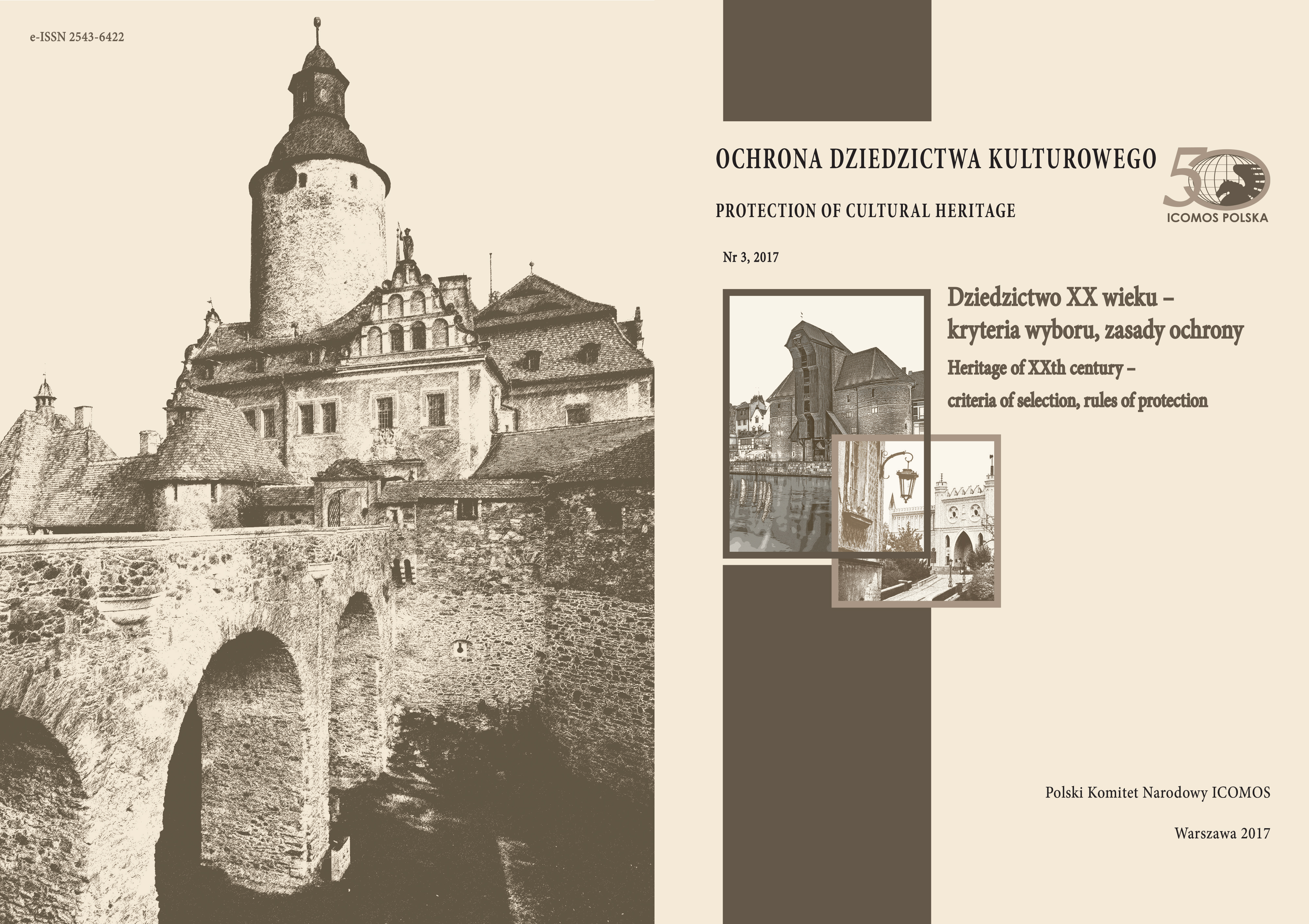Modernism as a particularly important Polish 20th century heritage. Criteria for selection and protection of modernist resource on the example of Stalowa Wola architecture
Article Sidebar
Open full text
Issue No. 3 (2017)
-
Protection of contemporary cultural goods in Lodz planning documents - defining the resource and rules of protection
Maria Dankowska7-18
-
Conservation issues and assumptions for the protection of objects of the former KL Auschwitz-Birkenau
Jolanta Banaś-Maciaszczyk, Rafał Pióro19-28
-
Copyright protection of the 20th century cultural heritage
Wojciech Kowalski29-44
-
The legacy of post-war architecture in Poland as a record of political, social and economic changes
Małgorzata Rozbicka45-68
-
Protection of cultural goods in the 2nd half of the XXth century in Silesia. Urban design, architecture, sculpture, mural
Helena Jadwiszczok-Molencka, Jacek Molencki69-85
-
How young can a monument be? The normative premises of stating the "validity" of immovable monuments
Marek Świdrak87-94
-
Authenticity versus sharing. Boundaries of compromises in the preservation of the former Auschwitz-Birkenau camp
Anna Łopuska95-106
-
Evaluation of the value of modernism monuments from the 1st half of the XXth century. Proposals of the classification methods
Jakub Lewicki107-124
-
Modernism as a particularly important Polish 20th century heritage. Criteria for selection and protection of modernist resource on the example of Stalowa Wola architecture
Grażyna Stojak125-131
-
Searching for criteria for the evaluation of modern wall paintings in historic churches in Poland
Małgorzata Korpała133-145
-
Industrial heritage - unwated heritage - unknown heritage
Jacek Dąbrowski147-160
-
Legacy of modernity in Japan - categories of valuation and examples
Waldemar J. Affelt161-178
-
Monuments of modernism as a defined resource of architectural heritage in the context of post-war facilities protection
Maciej Czarnecki179-186
Main Article Content
DOI
Authors
Abstract
In the publication the author presents the problems related to the conservatory protection of the modernist buildings in Stalowa Wola. The city,originally designed in the spirit of the prevailing ideas of modernism, has been built in the 1930’s of the interwar period. Ideological-conceptual coherence and its implementation determine the representativeness of the Stalowa Wola urban complex as a modernist cultural heritage.
The ongoing transformation processes force actions aimed at protecting this heritage. The author presents the necessity to analyze and evaluate the entire urban complex presenting assumptions to establish possible criteria and areas of analysis and evaluation. Among the others, it has beensuggested that the design concept and its implementation should be taken into account as a basic assessment criterion in the context of the changes that occurred after the Second World War.
After a brief reminder of the assumptions used in the design process of residential and service constructions, the author draws attention to the need to assess the impact of the currently ongoing investmentswhich have impact on the completeness and integrity of the architectural and urban complex of Stalowa Wola.
Intangible assets: the names of the streets, buildings, squares, the non-material values of the architectural sites and the architectural design of particular buildings and the cities as a whole, is another area that requires both research and protection. The problems resulting from the low awareness of the residents appear in this issue, and also appear in the proposed solutions for the design of the renovated and modernized buildings.
To solve most problems related to the protection of the conservator of modernist architecture and urban planning of Stalowa Wola, the creation of the Cultural Park is proposed. Both the arguments for its creation and its scope have been here presented.
Keywords:
References
Frąckiewicz A., Garanty A., Przesmycka E., Sieradzka A., Stańkowski M.A., Stalowa Wola. Europejskie miasto modernistyczne, Stalowa Wola 2014.
Furtak M., Centralny Okręg Przemysłowy (COP) 1936–1939. Architektura i urbanistyka. Kraj/region/miasto/ fabryka/osiedle/budynek, Kraków – Łódź 2014.
Kółeczko J., Reszczyński J., Stalowa Wola. 1938–1988, Wrocław 1988.
Molski P., Waloryzacja dziedzictwa architektonicznego w systemie ochrony zabytków, [w:] B. Szmygin (red.), System ochrony zabytków w Polsce – analiza, diagnoza, propozycje, Lublin – Warszawa 2011.
Sieradzka A., Szlakiem architektury art déco, Stalowa Wola 2008.
Stojak G., Komada D., Piękno tkwiące w prostocie. Problemy związane z konserwacją obiektów modernistycznych (na przykładzie architektury Stalowej Woli). Referat został złożony do druku w materiałach pokonferencyjnych. Konferencja na temat problematyki zachowania modernizmu była zorganizowana przez Regionalne Muzeum w Stalowej Woli w 2016 roku.
Witwicki M.T., Kryteria oceny wartości zabytkowej obiektów architektury jako podstawa wpisu do rejestru zabytków, „Ochrona Zabytków” 2007, nr 1.
Article Details
Abstract views: 322
Grażyna Stojak, University of Rzeszów
dr, adiunkt w Zakładzie Muzeologii Uniwersytetu Rzeszowskiego. Z wykształcenia - historyk
sztuki i pedagog, z praktyki - konserwator zabytków architektury i muzealnik. Praca zawodowa od
1986 roku. W latach 1996-2008 – muzealnik, praca w Muzeum Narodowym Ziemi Przemyskiej.
W 2005 roku obrona doktoratu. W latach 2008-2016 – Podkarpacki Wojewódzki Konserwator
Zabytków w Przemyślu. Obecnie pracownik naukowy Uniwersytetu Rzeszowskiego. Autorka kilku
książek i licznych artykułów o ochronie zabytków, sztuce XX wieku, historii fotografii, rewitalizacji
dziedzictwa kulturowego, pedagogiki wychowania przez sztukę. Kurator licznych wystaw sztuki
współczesnej, a także autorka esejów i wstępów do katalogów sztuki współczesnej.






